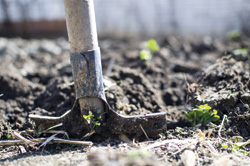Gardening myths or magic?
Gardening tips have been handed down for generations, but times move on, and opinions, fashions and practices can change. How do you know which guidance is wise, especially now that we are in the age of social media where cyberspace is teeming with conflicting advice? It’s always best to attempt to verify a tip before acting upon it unless you can afford to fail or achieve a less-than-perfect outcome!
1: Washing-up liquid is a great way to rid plants of aphids and other sap-sucking pests
When used in the kitchen, it dissolves greasy oils and fats so that they can easily be washed away. However, scientists distinguish between soap and detergents. Soaps are made from natural oils and fats, whereas detergents can often include phosphates, bleach, various enzymes, dyes and fragrances. The surfactants, as they are called, are synthetic chemicals.
Does it work? Spraying plant pests with a weak solution of washing-up liquid does tend to work. It probably washes off the waxy coating of the bug, making it vulnerable to drying out and dying. Some soap mixtures affect the nervous system too. What effect will these dead bugs have on wildlife that might consume them? This is not known. It’s a good idea to spray the plants with clean water shortly after using the washing-up liquid.
Does it harm plants? Detergents containing surfactants do present a real risk of harm to plants, known as phytotoxicity. Some plants are more sensitive than others, particularly sweet peas, cherries, plums, hawthorns and tomatoes. It can remove the protective natural oils and waxy surface from the leaves, thus reducing the plant’s defence against disease and more pests.
So, is washing-up liquid to combat pests a myth or a magical solution? It all depends on the type of soap solution you use. It can be magic, especially if you rinse them all in plain water afterwards.
2: The application of fertiliser kills bacteria in the soil
Organic gardening in tune with nature is undoubtedly best, if at all possible. However, is it true that artificial fertiliser damages soil microbes? It appears not.
Bacteria absorb nutrients in fertiliser, particularly nitrates, which helps them multiply. The only exception seems to be when synthetic fertilisers are applied in very large amounts, which creates toxins. The most significant difference between synthetic and organic fertilisers is the time they take to release their nutrients. Chemical fertiliser releases nutrients as soon as it dissolves in water, whereas organic matter releases them very slowly. This can be a major problem in heavy rain when the run-off takes the nutrients with it, depositing high levels in water courses.
 3: Digging is good for the soil
3: Digging is good for the soil
Digging and double-digging is something many of our parents and ancestors would have done. It’s a great way to get rid of weeds, incorporate organic matter into the soil, increase air pockets and help with drainage in compacted areas. Right?
Maybe not if we take the advice of today’s gardening experts and soil scientists. Not only is digging hard work, but it is generally thought to do more harm than good. It can quickly destroy the network of earthworm tunnels that provide air to roots, sever beneficial threads of fungus that work in harmony with plants, and disrupt the ecosystem (known as the food web) beneath the surface. It can also stimulate microbes that release greenhouse gases into the air.
Instead, use plants with long tap roots, such as common teasel, and vegetables like parsnip to break up compacted soil. Apply organic mulch to the surface, which will deter weeds and allow earthworms to take it down into the ground. Dig when you need to plant something new. Your back will thank you!
4: If a plant looks unhealthy, give it a feed
Kindness can kill! If a garden plant looks sick, the worst thing you can do is give it a dose of general fertiliser. This can stress the plant as it tries to put on more growth. Instead, look for the cause of the problem. It might simply have dry roots, in which case it can be watered thoroughly, or the pH levels of the soil might be wrong, leading to certain deficiencies. Get to know your plants and give them what they need rather than what you think they want.
By Caroline Knight


